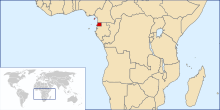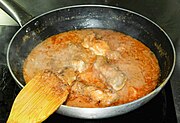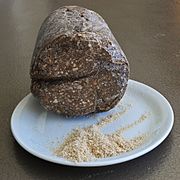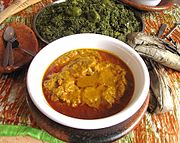Cuisine of Equatorial Guinea
- Machine translation, like DeepL or Google Translate, is a useful starting point for translations, but translators must revise errors as necessary and confirm that the translation is accurate, rather than simply copy-pasting machine-translated text into the English Wikipedia.
- Consider adding a topic to this template: there are already 5,016 articles in the main category, and specifying
|topic=will aid in categorization. - Do not translate text that appears unreliable or low-quality. If possible, verify the text with references provided in the foreign-language article.
- You must provide copyright attribution in the edit summary accompanying your translation by providing an interlanguage link to the source of your translation. A model attribution edit summary is
Content in this edit is translated from the existing Spanish Wikipedia article at [[:es:Gastronomía de Guinea Ecuatorial]]; see its history for attribution. - You may also add the template
{{Translated|es|Gastronomía de Guinea Ecuatorial}}to the talk page. - For more guidance, see Wikipedia:Translation.

The cuisine of Equatorial Guinea is a blend of the cuisines of the native peoples of this African country, including the Annobonese, the Bubi, the Fang, and the Kombe. It is also influenced by the cuisines of Spain (which colonized the country until 1968); other African nations such as Nigeria and Cameroon; Islamic states such as Morocco; and Creole cuisine overall. Its cuisine incorporates various meats, including game and bushmeat as well as imports, and is known for its strong flavors and high spice levels. Fish and chicken are common dishes.
While recipes vary from one community to another, the country's ethnic groups largely use the same ingredients.[1] Soups and stews predominate. Tubers like yuca and yam, traditionally served boiled or fried, serve as the base of the Equatoguinean diet. The tropical climate favors the cultivation of a multitude of vegetables, like eggplant, and fruits, like atanga. The jungle is a source for aromatic herbs and wild game.[2] Not unexpectedly, as fishing is a way of life for a large portion of Equatoguineans, the country's signature dish is pepesup (peppersoup), a spicy fish soup.[3] Meals generally center around stewed sauces. Dishes cooked wrapped in banana leaves are also common. Main dishes are usually accompanied by rice or boiled or fried yuca, malanga, or plantain. Dishes adopted from other countries include the Spanish tortilla and the Cameroonian ndolé.
Chilies and other spices are popular. Key ingredients in Equatoguinean cuisine come from local plants and animals, including plantains, sweet potato, breadfruit, cassava, yam, cocoyam (known locally as malanga), groundnuts, and snails.
As for desserts, a highlight is the dish akwadu, which features baked bananas with coconut. For drinks, specialties include topé (palm wine) and malamba.[4] Equatoguinean coffee and cocoa production peaked during the colonial period but has fallen significantly since,[5] and what is referred to as "chocolate" in the country, also known as modica, is actually the seed of the African mango (also known as ogbono) that's sold powdered or in a block.
Agriculture in Equatorial Guinea is not significantly industrialized and more commonly done on small farms. A large portion of the population still only has access to one meal a day. However, special events such as weddings are celebrated with large banquets.
Dishes
- Peppersoup, a West African soup that typically includes pepper, meats, and nutmeg;
- Sopa de pescado con cacahuete, a peanut (groundnut) soup with fish, onions and tomato;
- Bambucha, a stew or sauce of tender cassava leaves crushed and boiled with spices and juice of palm kernels (locally called dates). It is typically accompanied by boiled or fried plantain or yucca.
-
 Chicken in peanut sauce
Chicken in peanut sauce -
 Modica in a block
Modica in a block -
 Salted fish
Salted fish -
 Chicken with moambe sauce
Chicken with moambe sauce
See also
References
- ^ "Desde las cocinas de Guinea Ecuatorial (calendario)". Centro Cultural de España en Malabo (in Spanish). 2012. Retrieved 2022-10-25.
- ^ "África en los fogones" (PDF). Fundación Habitáfrica (in Spanish). 2011. Retrieved 2022-10-25.
- ^ "Comida típica ecuatoguineana". Iberia (in Spanish). Archived from the original on 2020-08-14.
- ^ "Equatorial Guinea Food and Dining". Archived from the original on 2010-04-02. Retrieved 2010-01-18.
- ^ "Cacao, café y madera en la colonización española de Guinea Ecuatorial". Tabakalera (in Spanish). 2016-04-14.
- v
- t
- e
- Algeria
- Angola
- Benin
- Botswana
- Burkina Faso
- Burundi
- Cameroon
- Cape Verde
- Central African Republic
- Chad
- Comoros
- Democratic Republic of the Congo
- Djibouti
- Egypt
- Equatorial Guinea
- Eritrea
- Eswatini (Swaziland)
- Ethiopia
- Gabon
- Gambia
- Ghana
- Guinea
- Guinea-Bissau
- Ivory Coast
- Kenya
- Lesotho
- Liberia
- Libya
- Madagascar
- Malawi
- Mali
- Mauritania
- Mauritius
- Morocco
- Mozambique
- Namibia
- Niger
- Nigeria
- Republic of the Congo
- Rwanda
- Saint Helena
- São Tomé and Príncipe
- Senegal
- Seychelles
- Sierra Leone
- Somalia
- South Africa
- South Sudan
- Sudan
- Tanzania
- Togo
- Tunisia
- Uganda
- Western Sahara
- Zambia
- Zimbabwe
 Category
Category


















